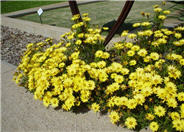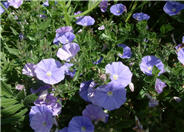
Common name:Arctotis Daisy, African Daisy
Botanical name:Arctotis hybrids
African Daisy hybrids grow 12"-18" high and 12" wide; they produce daisy-like flowers from spring through summer. These hybrids have lobed leaves and bloom in white, pink, red, purple, cream and orange.

Common name:Double Sunburst Coreopsis
Botanical name:Coreopsis grandiflora 'Double Sunburst'
The 'Double Sunburst' is a wonderful cultivar and a showy, Southern U.S. native. Golden yellow, double flowers on 2' bushy plants bloom from June to September in full sun and average to dry soils. It makes for good cut flowers, and pruning keeps the plants abundant with blooms.

Common name:Dwarf Morning Glory
Botanical name:Convolvulus sabatius
Convolvulus sabaticus is a perennial that grows 1'-2' high, with branches that spread to 3' or more. It produces blue to lavender flowers with blooms of 1"-2" wide. The soft, evergreen leaves are 1/2" to 1.5" long.

Common name:Tuscan Blue Upright Rosemary
Botanical name:Rosmarinus officinalis 'Tuscan Blue'
The Upright Rosemary is an upright shrub that grows 3'-6' tall. It has dark green leaves and bright, showy, lavender blue flowers throughout the year. This shrub is drought tolerant and attracts butterflies.

Common name:Shrub Rose
Botanical name:Rosa Shrub varieties
The dark green, heavily veined leaves of this bushy shrub are strong support for the pure white or pink, nearly double flowers it produces. This is a very tolerant, heavily scented plant with an impressive fall color. Also, large hips appear intermittently with this plant.

Common name:Artichoke
Botanical name:Cynara scolymus
This perennial will grow 4' tall and 6'-8' wide. It has silvery green leaves with bluish purple flowers that bloom in spring. Artichoke is a favorite fruit/vegetable of California kitchens but it is a great ornamental plant often overlooked for color contrast. It is very tolerant of little water when planted for ornamental purposes.
| Designer: Marilee Kuhlmann | Array of Colors |
Photographer: GardenSoft |
Soils and Compost:
Maintain a two to four inch layer of mulch on the soil surface to reduce weeds, infiltrate rain water, and reduce compaction.
Water Saving Tip:
Mulching around plants helps retain water and improves the soil.
Integrated Pest Management:
Develop healthy soil for plants that are vigorous and naturally pest-resistant.

